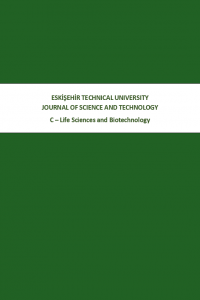Bazı 3-imino-4-sübstitüe-1,2,5-tiroidyazolidin 1,1-dioksitlerin antibakteriyel etkisi
Nocardia, sülfonamit, mikrodilüsyon MIC, MBC
ANTIBACTERIAL EFFECT OF SOME 3 -IMINO-4-SUBSTITUTED-1,2,5- THIADIAZOLIDINE 1,1-DIOXIDES
Nocardia, sulfonamides, microdilution MIC, MBC,
___
- Winum J Y, Scozzafava A, Montero J L,Supuran C T. Therapeutic potential of sulfamides as enzyme inhibitors. Journa., 2006. 26(6): p. 767-92.
- Bendjeddou A, Djeribi R, Regainia Z,Aouf N. N, N’-substituted 1, 2, 5 thiadiazolidine 1, 1-dioxides: synthesis, selected chemical and spectral proprieties and antimicrobial evaluation. Journa., 2005. 10(11): p. 1387-1398.
- Villalba M L, Palestro P, Ceruso M, Gonzalez Funes J L, Talevi A, Bruno Blanch L, Supuran C T,Gavernet L. Sulfamide derivatives with selective carbonic anhydrase VII inhibitory action. Journa., 2016. 24(4): p. 894-901.
- Abbaz T, Bendjeddou A, Gouasmia A, Bouchouk D, Boualleg C, Kaouachi N, Inguimbert N,Villemin D. Synthesis, Characterization and Antibacterial Activity of Cyclic Sulfamide Linked to Tetrathiafulvalene (TTF). Journa., 2014. 11(1): p. 59-63.
- Spaltenstein A, Almond M R, Bock W J, Cleary D G, Furfine E S, Hazen R J, Kazmierski W M, Salituro F G, Tung R D,Wright L L. Novel inhibitors of HIV protease: design, synthesis and biological evaluation of picomolar inhibitors containing cyclic P1/P2 scaffolds. Journa., 2000. 10(11): p. 1159-62.
- Zhong J, Gan X, Alliston K R,Groutas W C. Design, synthesis, and in vitro evaluation of inhibitors of human leukocyte elastase based on a functionalized cyclic sulfamide scaffold. Journa., 2004. 12(3): p. 589-93.
- Kim S J, Park H B, Lee J S, Jo N H, Yoo K H, Baek D, Kang B-w, Cho J-H,Oh C-H. Novel lβ-methylcarbapenems having cyclic sulfonamide moieties: Synthesis and evaluation of in vitro antibacterial activity. Journa., 2007. 42(9): p. 1176-1183.
- Supuran C T, Scozzafava A,Agents M. Carbonic anhydrase inhibitors. Journa., 2001. 1(1): p. 61-97.
- Gediz Erturk A,Bekdemir Y. Microwave-Assisted Synthesis of Some Substituted Sulfamides. Journa., 2014. 189(2): p. 285-292.
- Castro J L, Baker R, Guiblin A R, Hobbs S C, Jenkins M R, Russell M G N, Beer M S, Stanton J A, Scholey K, Hargreaves R J, Graham M I,Matassa V G. Synthesis and Biological-Activity of 3-[2-(Dimethylamino)Ethyl]-5-[(1,1-Dioxo-5-Methyl-1,2,5-Thiadiazolidin-2-Yl)-Methyl]-1h-Indole and Analogs - Agonists for the 5-Ht1d Receptor. Journa., 1994. 37(19): p. 3023-3032.
- Turnidge J,Paterson D L. Setting and revising antibacterial susceptibility breakpoints. Journa., 2007. 20(3): p. 391-408, table of contents.
- Bell S, Gatus B, Pham J,Rafferty D. Antibiotic susceptibility testing by the CDS method. Journa., 1999.
- Arslan N B, Erturk A G, Kazak C,Bekdemir Y. 3-Amino-4-[4-(dimethyl-amino)-phen-yl]-4,5-dihydro-1,2,5-thia-diazole 1,1-dioxide. Journa., 2011. 67(Pt 7): p. o1736.
- Lee C H, Korp J D,Kohn H. 3-Oxo-and 3-imino-4-substituted-1, 2, 5-thiadiazolidine 1, 1-dioxides: synthesis, spectral properties, and selected chemistry. Journa., 1989. 54(13): p. 3077-3083.
- CLSI. Methods for dilution antimicrobial susceptibility tests for bacteria that grow aerobically; approved standard, Ninth Edition (M07-A9). 2012, CLSI Wayne, PA, USA.
- CLSI. Susceptibility Testing of Mycobacteria, Nocardiae, and Other Aerobic Actinomycetes—Second Edition: Approved Standard M24-A2. 2011, CLSI Wayne, PA, USA.
- CLSI. Development of in vitro susceptibility testing criteria and quality control parameters; approved guideline, Fourth Edition (M23) 2016, CLSI Wayne, PA, USA.
- CLSI. Performance standards for antimicrobial susceptibility testing; twenty-six informational supplement (M100S). 2016, CLSI Wayne, PA, USA.
- Wiegand I, Hilpert K,Hancock R E. Agar and broth dilution methods to determine the minimal inhibitory concentration (MIC) of antimicrobial substances. Journa., 2008. 3(2): p. 163-75.
- Brown-Elliott B A, Biehle J, Conville P S, Cohen S, Saubolle M, Sussland D, Wengenack N, Kriel K, Bridge L, McNulty S, Vasireddy R,Wallace R J, Jr. Sulfonamide resistance in isolates of Nocardia spp. from a US multicenter survey. Journa., 2012. 50(3): p. 670-2.
- Clark N M, Reid G E,Practice A S T I D C o. Nocardia infections in solid organ transplantation. Journa., 2013. 13 Suppl 4(s4): p. 83-92.
- Schlaberg R, Fisher M A,Hanson K E. Susceptibility profiles of Nocardia isolates based on current taxonomy. Journa., 2014. 58(2): p. 795-800.
- Welsh O, Vera-Cabrera L,Salinas-Carmona M C. Current treatment for nocardia infections. Journa., 2013. 14(17): p. 2387-98.
- Southwick F S. Infectious Diseases: Nocardia Species. Overview: What Every Clinician Needs To Know. [Access date: 19.02.2019]; Available from: https://www.clinicalpainadvisor.com/infectious-diseases/nocardia-species/article/610646/?utm_source=TrendMD&DCMP=OTC-CPA_trendmd&dl=0.
- Argyropoulou I, Geronikaki A, Vicini P,Zani F. Synthesis and biological evaluation of sulfonamide thiazole and benzothiazole derivatives as antimicrobial agents. Journa., 2009. 6: p. 89-102.
- Bendjeddou A, Abbaz T, Ayari A, Benahmed M, Gouasmia A,Villemin D. Antibacterial Activity and Global Reactivity Descriptors of some Newly Synthesized Unsymmetrical Sulfamides. Journa., 2016. 32(2): p. 799-806.
- Berredjem M, Bouchareb F, Kaki S A, Dekhil M,Aouf N E. Synthesis and antibacterial activity of novel N-acylsulfonamides. Journa., 2017. 10: p. S1095-S1099.
- Gediz Ertürk A., Atli Şekeroğlu Z., Kontaş Yedier S.,V. Ş. 3-Amino-4-[4-(Dimetilamino)Fenil]-4,5-Dihidro-1,2,5-Tiyadiazol 1,1-Dioksit Bileşiğinin Kromozom Hasarı Üzerindeki Etkisi. in Uluslararası Katılımlı “5. İlaç Kimyası: İlaç Etkin Maddesi Tasarımı, Sentezi, Üretimi Ve Standardizasyonu Kongresi 30.03.2017 - 02.04.2017 of Conference. Turkey, Antalya.
- ISSN: 2667-4203
- Yayın Aralığı: Yılda 2 Sayı
- Başlangıç: 2010
- Yayıncı: Eskişehir Teknik Üniversitesi
KANSER İMMÜNOTERAPİSİNDE KULLANILMAK ÜZERE PHBHHX BAZLI KATI LİPİD NANOPARTİKÜL DİZAYNI
Bazı 3-imino-4-sübstitüe-1,2,5-tiroidyazolidin 1,1-dioksitlerin antibakteriyel etkisi
Elif ÇİL, Ceren BÖRÇEK KASURKA, Aliye GEDİZ ERTURK, Seval KONTAŞ
Selin ÇİM, Hülya ALTUNTAŞ, Ayşe AK
Ayşe GENÇER, Emrah AKGEYİK, Mustafa Sinan KAYNAK, Mustafa ÇELEBİER, Murat Sami BERKMAN, Selma ŞAHİN
